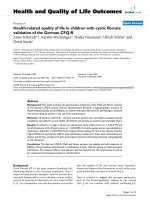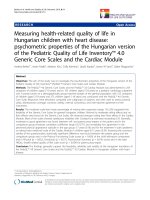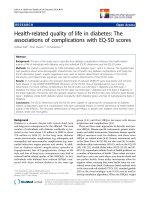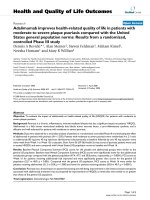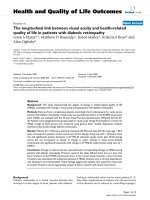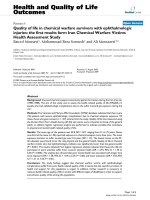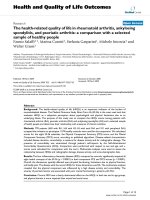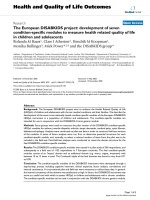Measuring the Quality of Life in Children with Asthma in Da Nang City, Viet Nam
Bạn đang xem bản rút gọn của tài liệu. Xem và tải ngay bản đầy đủ của tài liệu tại đây (1.54 MB, 103 trang )
輔英科技大學護理系碩士在職專班
碩士論文
Department of Nursing
Fooyin University
Master Thesis
衡量越南岘港市哮喘患童的生活品質
Measuring the Quality of Life in Children with Asthma
in Da Nang City, Viet Nam
研究生:范氏草
Graduate Student:Pham Thi Thao
指導教授:李佩育副教授
Advisor:Associate Professor Pei-Yu Lee
中
華
民
國 108 年 07 月
July, 2019
Fooyin University
Recommendation Letter from the Thesis Advisor
i
Fooyin University
Thesis/Dissertation Oral Defense Committee Certification
ii
ACKNOWLEDGEMENTS
I would first like to thank my thesis advisor Associate Professor Pei-Yu Lee of
the School of Nursing at Fooyin University in Taiwan. She was always ready
whenever I ran into a trouble spot or had a question about my research or writing.
She consistently allowed this paper to be my own work, but steered me in the
right the direction whenever she thought I needed it.
My sincere thanks also goes to Duy Tan University for giving me the
opportunity to participate in this course. Without their precious support it would
not be possible to conduct this research.
I would also like to thank the experts who were involved in the validation
survey for this research project: M.S. Nguyen Dieu Hang, M.S. Tran Thi Kim
Quy, M.S. Pham Ngoc An and Mr. Gary Michael Sanchez. Without their
passionate participation and input, the validation survey could not have been
successfully conducted.
Finally, I must express my very profound gratitude to my parents, friends and
colleagues for providing me with unfailing support and continuous
encouragement throughout my years of study and through the process of
researching and writing this thesis. This accomplishment would not have been
possible without them.
I want to say “Thank you” to all of you again.
Master student:
Pham Thi Thao
iii
衡量越南岘港市哮喘患童的生活品質
摘要
背景:現今治療哮喘的成本是世界各國的巨大醫療負擔。哮喘復發的症狀
經常導致失眠,白天疲勞,活動能力降低和影響上學。影響兒童的發展特
徵是包括身體,心理,情感,社交和智力。因此,哮喘會使兒童的生活品
質大大降低。
目的:本研究的目的包括(1)探索哮喘患兒的生活品質;(2)評估哮喘症
狀控制標準;(3)醫療檢查與哮喘兒童生活品質的相關性。
方法:本研究是量性橫斷面,描述性研究設計。於 2019 年 1 月至 5 月間在
峴港市的峴港醫院和海洲綜合醫院共招募了 122 名 5-15 歲被診斷患有哮喘
病童,經本人及監護人同意後填寫問卷。其問卷內容包括:(1)人口統計
學特徵(包括兒童及其父母或監護人);(2)生活品質問卷和(3)哮喘控
制問卷。使用 SPSS 16.0 統計軟件分析其數據。
結果:大多數兒童的平均生活品質(QoL)結果(M = 67.8±9.48)為
27.9%的兒童控制不佳,48.4%的兒童部分控制佳,23.8%的兒童控制良
好。哮喘病童的生活品質與哮喘症狀控制水平(p <0.001),哮喘持續時
間(p <0.05),父母教育程度(p <0.01)和婚姻狀況(p <0.01)是存在
差異的。而在哮喘病童的生活品質與年齡,性別,家庭收入和吸煙者家庭
方面是沒有顯著差異(p> 0.05)。
結論:哮喘症狀控制水平較高的兒童 QoL 評分較高。因此,控制哮喘和決
定 QoL 標準這兩項因素是可以改善哮喘病童的生活品質。
關鍵詞:哮喘,兒童,生活品質
iv
MEASURING THE QUALITY OF LIFE IN CHILDREN
WITH ASTHMA IN DA NANG CITY, VIET NAM
ABSTRACT
Background: Nowadays, the cost of treatment for asthma is a huge burden in all
countries of the world. Symptoms of asthma relapse frequently and can cause
insomnia, daytime fatigue, reduced activity levels and schooling. Children are
characterized by physical, mental, emotional, social and mental development.
Therefore, asthma reduces the quality of life of children.
Aim: The aims of this study were (1) To explore the quality of life in the
children with asthma; (2) To assess the level of asthma symptoms control; (3) To
examine the correlations to the quality of life of children with asthma.
Methods: The study was a quantitative, cross-sectional, descriptive design. 122
children from the ages of 5-15 diagnosed with asthma were recruited between
January 2019 and May 2019 in Da Nang Hospital for Women and Children and
Hai Chau General Hospital in Da Nang City. This study used questionnaires
including: (1) demographic characteristics (including child and their parents or
guardians), (2) quality of life instrument and (3) Asthma control questionnaire.
The data was analyzed using the SPSS 16.0 statistical software.
Results: Most children are assessed for their quality of life (QoL) at an average
level (M=67.8±9.48). 27.9% of children were uncontrolled, 48.4% partially
controlled and 23.8% controlled well. There is a difference between the QoL of a
child with asthma and the level of asthma symptoms control (p <0.001), duration
of asthma years (p <0.05), educational level (p <0.01) and marital status (p <0.01)
of the child's parents. There is no difference between the QoL of children with
asthma and age, gender, family income and smokers' families (p >0.05).
Conclusion: Asthma in children with a better level of symptom control had a
higher QoL score. Controlling asthma and the main factors that determine QoL
scores can improve a child's QoL.
Keywords: Asthma, Children, Quality of life
v
TABLE OF CONTENTS
Recommendation Letter from the Thesis Advisor ..................................................... i
Thesis/Dissertation Oral Defense Committee Certification ..................................... ii
Acknowledgements .................................................................................................. iii
Abstract (Chinese version) ....................................................................................... iv
Abstract (English version)......................................................................................... v
Table of contents ...................................................................................................... vi
List of tables ........................................................................................................... viii
List of figures ............................................................................................................ x
List of abbreviations ................................................................................................. xi
Chapter 1: Introduction ............................................................................................. 1
1.1. Statement of the Problem ............................................................................. 1
1.2. Prevalence of Asthma in Viet Nam.............................................................. 4
1.3. Research purposes ........................................................................................ 6
1.4. Research Questions ...................................................................................... 6
1.5. Significance of the study .............................................................................. 6
1.6. Conceptual definitions ................................................................................. 7
1.7. Summary ...................................................................................................... 8
Chapter 2: Literature Review .................................................................................... 9
2.1. Outline of asthma ......................................................................................... 9
2.2. Quality of life ............................................................................................. 17
2.3. Asthma and quality of life .......................................................................... 25
2.4. Summary .................................................................................................... 28
Chapter 3: Methodology.......................................................................................... 29
3.1. Research design .......................................................................................... 29
3.2. Conceptual Framework .............................................................................. 30
3.3. Sampling & Setting .................................................................................... 30
vi
3.4. Instruments ................................................................................................. 32
3.5. Process of Questionnaire Translation ........................................................ 35
3.6. Research process ........................................................................................ 36
3.7. Data collection ........................................................................................... 37
3.8. Data Analysis ............................................................................................. 41
3.9. Ethical consideration .................................................................................. 41
3.10. Summary .................................................................................................. 42
Chapter 4. Result ..................................................................................................... 43
4.1. Demographic data ...................................................................................... 43
4.2. The level of asthma symptoms control ...................................................... 45
4.3. Reliability Test of the Questionnaire ......................................................... 46
4.4. Scores of total PedsQL and its domains .................................................... 46
4.5. Summary .................................................................................................... 53
Chapter 5. Discussion And Conclusion .................................................................. 55
5.1. Discussion .................................................................................................. 55
5.2. Limitations of the Study ............................................................................. 62
5.3. Suggestions ................................................................................................ 63
5.4. Conclusion.................................................................................................. 64
5.5. Summary .................................................................................................... 64
References ............................................................................................................... 66
Appendix ................................................................................................................. 76
Appendix A: Questionnaire (English version) .................................................. 76
Appendix B: Questionnaire (Vietnamese version) ........................................... 81
Appendix C: Agreement Form (English version) ............................................. 86
Appendix D: Agreement Form (Vietnamese version) ...................................... 87
Appendix E: Permission from Questionnaire ................................................... 88
Appendix F: Permission from Hospitals ........................................................... 89
Appendix G: Grammar Editing Permit ............................................................. 91
vii
LIST OF TABLES
Table 1. Diagnostic criteria for asthma in adults, adolescents, and children from
age 6–11 year-old (GINA, 2018)……………………………………………….11
Table 2. Factors suggesting the possibility of patients with asthma (Ministry of
Health of Vietnam, 2016). ……………………………………………………...13
Table 3. Laboratory tests (Ministry of Health of Vietnam, 2016)…………….. 14
Table 4. GINA assessment of asthma control in adults, adolescents and children
from age 6–11 year-old (GINA, 2018)………………………………………... 17
Table 5. Characteristics of the questionnaire about quality of life for children and
adolescents with asthma………………………………………………………...21
Table 6. How to convert points of items………………………………………..33
Table 7. Characteristics of the questionnaire assesses the level of asthma
symptom control based on GINA criteria……………………………………....35
Table 8. Scale reliability (n = 30)……………………………………………….37
Table 9. Item and Scale CVIs…………………………………………………..39
Table 10. Demographic details of children……………………………………. 43
Table 11. Demographic details of parents or guardians of children…………... 44
Table 12. Asthma control situation in the past 1 month………………………..45
Table 13. The level of asthma symptoms control………………………………46
Table 14. Scale reliability (formal survey with n = 122 participants)………… 46
Table 15. Mean and Standard deviation of Physical Functioning……………...47
Table 16. Mean and Standard deviation of Emotional Functioning……………49
Table 17. Mean and Standard deviation of Social Functioning………………...49
viii
Table 18. Mean and Standard deviation of School Functioning……………......50
Table 19. Mean and Standard deviation of Scores of total PedsQL and its
domains…………………………………………………………………………50
Table 20. Children's demographic characteristics in relation to their quality of
life (T-test).…………………………………………………………………......51
Table 21. Parents or guardians' demographic characteristics in relation to their
quality of life (T-test)……………………………………………………...........52
Table 22. Parents or guardians’ demographic characteristics in relation to their
quality of life (ANOVA)………………………………………………………..53
Table 23. Relationship between the level of symptom control and the quality of
life of children (ANOVA)………………………………………………………54
ix
LIST OF FIGURES
Figure 1: Diagram of pathological process of bronchial asthma (Expert Panel
Report 3, 2007)…………………………………………………………………...9
Figure 2. Conceptual Framework……………………………………………….30
Figure 3. The required sample size was calculated by using the G*Power version
3.0.10……………………………………………………………………………32
x
LIST OF ABBREVIATIONS
Abbreviation
Meaning
QoL
Quality of life
HRQoL
Health-related quality of life
WHO
World Health Organization
GINA
The Global Initiative for Asthma
FEV
Forced expiratory volume in 1 second
BD
Bronchodilator (short-acting SABA or rapid-acting
LABA)
PEF
Peak expiratory flow
SABA
Short-acting beta-agonist.
NAEPP
The National Asthma Education and Prevention Program
PedsQL™ 4.0
The Pediatric Quality of Life Inventory™ Version 4.0
EPR-3
Expert Panel Report 3
LABA
Long-acting beta-agonist
CAQ
Childhood Asthma Questionnaires
PAQLQ
Paediatric Asthma Quality of Life Questionnaire
PACQLQ
Paediatric Asthma Caregiver’s Quality of Life
Questionnaire
AAQOL
Adolescent Asthma Quality of Life Questionnaire
TACQOL-asthma
TNO-AZL Child Quality of Life of asthma
xi
CHAPTER 1: INTRODUCTION
This chapter focuses on the statement of the problem, prevalence of asthma in
Viet Nam, research purpose, research questions, significance of the study and
conceptual definitions.
1.1. Statement of the Problem
According to the World Health Organization (WHO) estimates, by 2015 there
were 383,000 deaths due to asthma. Asthma is a non-communicable disease,
characterized by continuous attacks of shortness of breath and wheezing, the
severity and frequency of asthma are not the same for each person. Symptoms
may occur several times a day or a week in those affected and for some people
the symptoms become worse with physical activity or at night. In an asthma
attack, the lining of the bronchial tubes swells, narrowing the airways and
reducing air and reducing the amount of air entering and exiting the lungs.
Symptoms of recurrent asthma induce insomnia, daytime fatigue, decreased
activity and absenteeism in school and the workplace. Drugs that control asthma
and the prevention of asthma triggers can also reduce the severity of the disease.
Proper management of asthma can help people achieve better quality of life
(World Health Organization, 2017).
Nowadays, the cost of treatment for asthma is a huge burden on all the
countries of the world. Most studies on the burden of asthma come from
developed countries, where large national disease surveys and large
administrative databases can be integrated to provide a broad picture of the
burden. Indirect costs of asthma are at least equal to its direct cost. Deficiencies
from asthma affect people most at their peak productive working age, and
parents of children with asthma are also of working age. Even, the loss of
individual productivity at work is greater than the inability to work in patients
1
with asthma. A study in Canada has shown that uncontrolled asthma leads to a
loss of $ 184 Canadian dollars in 2012 for per person per week. Thus, 90% of
them are due to lost function at work (The Global Asthma Report, 2018).
According to the survey by Lai in eight countries in the Pacific region
including Vietnam, the rate of school dropout for asthma is 36.5% (Lai C., et al,
2003). A study by Dang Huong Giang conducted in Thanh Xuan and Long Bien
District, Hanoi in 2012 shows asthma has made 11.3% of children in Thanh
Xuan district and 8.3% of children in Long Bien district have to miss school
(Giang, 2012).
While most epidemiological data on asthma are available in developed
countries, information on these diseases in developing countries in Southeast
Asia is very rare. Costs based on the incidence of each new asthma case in
Vietnam is 70,019,897 VND, of which costs for medicines and health services
account for 60.55% and 39.45%. The cost of asthma diagnosis and management
throughout life is 51,459,674 VND per person, which is about 2.77 times higher
than the cost of treating asthma (18,560,224 VND). With nearly 231,260 new
cases of asthma annually, Vietnam has an economic burden based on the
prevalence of asthma in its life cycle of about VND 16,193 billion (Nguyen et al.,
2014).
According to the Vietnamese children's law, “Children are classified under 16
years old.” (Children's law number: 102/2016 / QH13, 2016). Adolescence is the
age of transition between childhood and adulthood along with many changes and
developments in physical, mental, emotional, sexual and social aspects. This is
the age that begins the individual's efforts to achieve the goals related to cultural
expectations of society. While asthma is one of the major diseases common in
childhood and adolescence and its consequences not only affect the patient but
also the whole family, with the ability to cause complex problems and have
2
lasting effects. Adolescents have many problems to deal with, then combined
with a chronic illness such as asthma so these adolescents may experience
feelings of failure, anger, lack of hope, lack of self-esteem, self-censorship and
fear. These things become more burdensome for them (Nogueira et al., 2009).
According to Sawyer and colleagues, in a cohort study, quality of life (QoL)
decreased in adolescents with chronic diseases such as diabetes and asthma
(Sawyer et al., 2004). QoL in patients with chronic diseases, especially asthma is
one of the focuses of this research. Nowadays, Asthma is a chronic disease with
considerable burden on health, economy and the most frequent chronic disorder
in childhood. Despite growing knowledge about causes and treatment, many
patients with uncontrolled asthma are still limited in social activities and have a
reduced quality of life (QOL). The WHO also defines “health is a state of
complete physical, mental and social well-being and not merely the absence of
disease or infirmity” (World Health Organization, 2006). So, quality of life has
become an important concept in evaluating health care, in both child and adult
populations. WHO defines “Quality of Life as individuals’ perception of their
position in life in the context of the culture and value systems in which they live
and in relation to their goals, expectations, standards and concerns. It is a broad
ranging concept affected in a complex way by the person's physical health,
psychological state, level of independence, social relationships, personal beliefs
and their relationship to salient features of their environment” (Programme on
mental health, 1997). A nurse needs to be concerned with the quality of life and
well-being of a patient. Asthma causes a serious burden on the quality of life
related and its relation to the health of children, although effective and safe
treatments are available (GINA Executive Committee, 2010). A common goal in
asthma management is to achieve optimal disease control and improve the
quality of life related to health (Pedersen et al., 2011). According to Prof. Dr.
3
Ngo Quy Chau, asthma and chronic obstructive pulmonary disease in particular
and respiratory diseases in general have not been properly observed in Vietnam.
The rate of asthma in Vietnam is 4.1% of the population. However, only 29.1%
of asthma patients used maintenance therapy and 39.7% of patients had good
asthma control. Currently, children ages 12 to 13 have the highest rate of asthma
in Asia and this number is on the rise (Ministry of health portal, 22/9/2017).
However, in Vietnam in general and Da Nang city in particular, studies on the
quality of life in children with chronic diseases, especially asthma is limited. The
lack of understanding of factors that reduce quality of life may prevent nurses
from planning with children and parental care efforts to address the need for
improved quality of life for children with asthma in the future. Thus, the study
focused on the quality of life of children with asthma. This study will provide
background information on the quality of life in asthmatic children.
1.2. Prevalence of Asthma in Viet Nam
In Vietnam, epidemiological studies of bronchial asthma in the community is
still very limited. Until the year 2010, Vietnam had conducted the first
investigation on asthma in adults across the country, which showed that the
prevalence of asthma in Vietnamese adults is 4.1%. People with asthma,
Vietnam has about 4 million patients (Hanh & Doan, 2012). 64.9% of patients
had to go to the emergency room because of severe asthma (Hanh & Doan, 2013)
and the rate of asthma prevention only reached 26.2%. The situation of
controlling asthma in children in Vietnam is more alarming as more than 80% of
children with asthma under 15 years have not been treated for asthma prevention
(Hanh & Doan, 2013).
According to a survey of high school students in 3 schools in Hanoi, on
average, 5% of the population had asthma, of which 11% of children were under
15 years old, equivalent to 4 million people with asthma and the number of
4
deaths per year are approximately 3,000. Many people still hide their disease, so
it is easy to miss the epidemiological investigation as well as diagnosing the
disease (Doan & Long, 2006).
In Vietnam so far data on the incidence and death because of asthma related
complications are still quite limited. In 2003, Pham Le Tuan published the
results of studying asthma in pupils in Hanoi by clinical examination and skin
test results bronchial asthma of children in the inner city is 12.56%, the suburban
is 7.52% (Tuan, 2004).
In Hanoi, the ISAAC interview form was used in 2005 to investigate the
incidence of wheezing in children in two elementary schools in Hanoi (aged 5-11
years), found that the rate of wheezing was 29.1% (Giang, Dung & Anh, 2010).
In 2010, the rate of wheezing in children aged 13-14 in Thanh Tri district in
Hanoi is 15.1%, while the rate of children diagnosed with asthma was 2.6%
(Giang, Dung & Anh, 2010).
In Da Lat in 2004, Sy DQ conducted a survey in children aged 5-15 years, the
results showed that the incidence of asthma and asthma symptoms was 3.4% (Sy,
Thanh Binh, Quoc et al., 2007).
In the Mekong Delta, Huynh Cong Thanh interviewed 940 parents of grade 12 students in Tien Giang province in 2007 showing that in the rate of children
with a wheezed was 9%, diagnosed asthma was 2.2% (Thanh & Tram, 2009).
That same year in Can Tho the number of children from 13-14 years old are
with a wheeze accounted for 5%, had been diagnosed with asthma was 1.4%
(Hai & Hong, 2009).
Nationally, in 2010, research on the identified asthma of adults aged 16 to
over 80 in 7 Eco regions of Vietnam using the screening interview method
ECRHS and medical examinations. The incidence of asthma in Vietnamese
adults is 4.1%. Men have higher morbidity rates than women. The highest rate of
5
asthma in Nghe An was 7.65% and the lowest was Binh Duong at 1.51%. Thus,
there is a difference in the incidence of asthma rates among different regions of
Vietnam (Hanh & Doan, 2012). According to the 2010 survey, the mortality
from asthma in the period 2005 - 2009 in Vietnam was 3.78 cases / 100,000
people in all cities and provinces in Vietnam, the mortality from asthma is on the
rise (Hanh & Truong, 2012).
With the epidemiological characteristics of asthma as we know that asthma is
a real economic burden for every country.
1.3. Research purposes
1. To explore the quality of life in the children with asthma.
2. To assess the level of asthma symptom control.
3. To examine the relationship between the quality of life of children with
asthma and two other factors: (i) demographic characteristics, (ii) level of
asthma symptoms control.
1.4. Research Questions
1. How severities of asthmatic children affect the quality of life?
2. How is the level of asthma symptoms control in children?
3. Is there a relationship between the quality of life of asthmatic children with
demographic characteristics and the level of asthma symptom control?
1.5. Significance of the study
Asthma often limits the ability to learn, play, and live with healthy children
due to the symptoms of the disease. Children with asthma are more likely to
develop acute asthma when taking part in strenuous activities such as playing
sports, changing weather, exposure to allergens... forces children to miss school
days. Some children are pessimistic and discouraged, because they can’t keep up
with their friends or because they feel they are burden for their families. These
6
things decrease the quality of life of children. Specifically, children of this age
group (5 to 15 years old) start to be more aware of society, start going to school,
participate in school and group activities and have many changes in thinking.
Currently, research on the quality of life of asthmatic children in Vietnam is very
seldom. Based on that fact, I conducted research on this topic.
1.6. Conceptual definitions
Demographic characteristics: In the parents or guardians of the child, the
personal information that was included was: age, academic level, income, marital
status; in the children the personal information section included was: age,
gender, duration of disease, disease history, smoking history.
“The level of asthma control: is the extent to which the manifestations of
asthma can be observed in the patient, or have been reduced or removed by
treatment” (GINA, 2018).
Quality of Life:
WHO defines “Quality of Life as an individuals’ perception of their position
in life in the context of the culture and value systems in which they live and in
relation to their goals, expectations, standards and concerns. It is a broad ranging
concept affected in a complex way by the person's physical health, psychological
state, level of independence, social relationships, personal beliefs and their
relationship to salient features of their environment. The four domains of quality
of life include physical health, psychological, social relationships and
environment” (Programme on mental health, 1997).
Asthma:
“Is a chronic inflammatory disorder of the airways in which many cells and
cellular elements play a role. The chronic inflammation is associated with airway
hyper-responsiveness
that
leads
to
recurrent
episodes
of
wheezing,
breathlessness, chest tightness and coughing, particularly at night or early in the
7
morning. These episodes are usually associated with widespread, but variable
airflow obstruction within the lung that is often reversible either spontaneously
or with treatment” (GINA, 2018).
Children:
“Is under 16 years old.” (Children's law number: 102/2016 / QH13, 2016). In
this study, the participants were 5 to 15 years old.
1.7. Summary
Asthma is one of the main diseases that occurs in childhood and adolescence.
It not only affects the patient but also the whole family. The cost of treatment for
asthma is a huge burden on all countries of the world. Asthma often limits the
ability to learn, play, and live with healthy children due to the symptoms of the
disease. These things decrease the quality of life of children. Besides, the
information on the quality of life of asthmatics in developing countries in
Southeast Asia (such as Vietnam etc…) are limited.
8
CHAPTER 2: LITERATURE REVIEW
This chapter describes an overview of the literature to assess research issues
within a broader context and to demonstrate the need to conduct research in this
particular asthma population. Document assessment is an important step in the
research process and allows researchers to perform research in the amount of
knowledge available. This review of the literature includes an outline of asthma,
quality of life and relationship between asthma and quality of life.
2.1. Outline of asthma
2.1.1. Definition of asthma
There are many definitions of asthma:
An international consensus report defined asthma as a “common chronic
disorder of the airways that is complex and characterized by variable and
recurring symptoms, airflow obstruction, bronchial hyper-responsiveness, and an
underlying inflammation. The interaction of these features of asthma determines
the clinical manifestations and severity of asthma and the response to treatment”
(Expert Panel Report 3, 2007).
Figure 1: Diagram of pathological process of bronchial asthma (Expert
Panel Report 3, 2007).
9
The Global Initiative for Asthma (GINA) 2018 definition is: “Asthma is a
heterogeneous disease, usually characterized by chronic airway inflammation. It
is defined by the history of respiratory symptoms such as wheeze, shortness of
breath, chest tightness and cough that vary over time and in intensity, together
with variable expiratory airflow limitation.” This definition was reached by
consensus, based on consideration of the characteristics that are typical of
asthma and that distinguish it from other respiratory conditions (GINA, 2018).
2.1.2. Etiology of and risk factors for asthma
Asthma consists of a variety of heterogeneous phenotypes, different in the
way of expression, cause and pathophysiology. Risk factors for each type of
asthma recognized include genetic, environmental and host factors. Although
patients with asthma have a family history of asthma that is common, but this
factor is not enough or is not necessary for the development of asthma (Burke,
Fesinmeyer, Reed, Hampson & Carlsten, 2003).
The incidence of asthma varies widely around the world, possibly due to the
interaction between genes and the environment.
A mother that smokes, diet, nutrition, stress, the use of antibiotics and
caesarean section may be prenatal risk factors for asthma.
The risk factors for asthma in childhood may include allergy sensitivity,
environmental tobacco smoke, animal exposure, decreased lung function in
infancy, breastfeeding, structure and size family, socio-economic status,
antibiotics and infections and gender.
For asthma in adults, occupational exposure is a common risk factor
(Subbarao, Mandhane & Sears, 2009).
2.1.3. Clinical diagnosis of asthma
The diagnosis of asthma is based on the identification of a specific type of
respiratory symptoms such as dyspnea (chest pain), wheezing, chest tightness or
10
cough and limited airflow. The pattern of symptoms is important, because
respiratory symptoms may be due to acute or chronic diseases in addition to
asthma.
Typical respiratory symptom pattern of asthma
The following characteristics are typical of asthma and, if available, it
increases the likelihood of patients having asthma:
• The symptoms vary according to time and intensity
• Symptoms are usually worse at night or early in the morning
• The symptoms vary according to time and intensity
• Symptoms that are triggered by exercise, exposure to allergens, viral infections
(colds), weather changes, laughter, or stimulants such as exhaust fumes of cars,
smoke or strong odors (GINA, 2018).
Table 1. Diagnostic criteria for asthma in adults, adolescents, and children
from age 6–11 year-old (GINA, 2018).
DIAGNOSTIC FEATURE
CRITERIA FOR MAKING THE
DIAGNOSIS OF ASTHMA
1. History of variable respiratory symptoms
- Shortness of breath, wheeze, chest
• In general, there is more than one type
tightness and cough
of respiratory symptoms (in adults,
- Descriptors may vary between
isolated cough is rarely due to asthma)
cultures and by age, e.g. children
• Symptoms occur change over time and
may be described as having heavy
different intensities
breathing
• Symptoms are usually worse at night or
on waking
• Symptoms usually triggered by
allergens, exercise, laughter, cold air
11
• Symptoms usually appear or become
worse with a viral infection
2. Confirmed variable expiratory airflow limitation
Documented excessive variability in The greater the variations, or the more
lung function* (one or more of the
occasions excess variation is
tests below)
seen, the more confident the diagnosis
AND documented airflow
At least once during diagnostic process
limitation*
(e.g. when FEV is low), confirm that
FEV1/FVC is reduced (normally > 0.90 in
children)
Positive bronchodilator (BD)
Children: increase in FEV of >12%
reversibility test* (more likely to be
predicted.
positive if BD medication is
withheld before test: SABA ≥4
hours, LABA ≥15 hours)
Excessive variability in twice-daily
Children: average daily diurnal PEF
PEF over 2 weeks*
variability >13%**
Positive exercise challenge test*
Children: fall in FEV1 of >12% predicted,
or PEF >15%
Excessive variation in lung function
Children: variation in FEV of >12% in
between visits* (less reliable)
FEV1 or >15% in PEF between
visits (may include respiratory infections)
BD: bronchodilator (short-acting SABA or rapid-acting LABA); FEV: forced expiratory
volume in 1 second; LABA: long-acting beta-agonist; PEF: peak expiratory flow (highest of
three readings); SABA: short-acting beta-agonist.
*These tests can be repeated during symptoms or in the early morning.
12
**Daily diurnal PEF variability is calculated from twice daily PEF as ([day’s highest minus
day’s lowest] / mean of day’s highest and lowest), and averaged over one week. For PEF, use
the same meter each time, as PEF may vary by up to 20% between different meters (GINA,
2018).
No reliable test only (or gold standard) and no standard diagnostic criteria for
asthma.
Clinical diagnosis of asthma in children includes consideration:
- The history of wheezing recurrence or prolonged.
- The presence of allergies or family history of asthma and allergies.
- The absence of physical findings suggesting diagnostic alternatives.
- Diagnostic tests that support diagnosis (e.g. spirometry in children can
perform tests).
- Clinical response consistent with inhaled bronchodilators or preventer drugs.
(Australia, National Asthma Council, 2016).
According to the Decision No. 4888 / QD-BYT issued on September 12, 2016
of the Ministry of Health of Vietnam on "Guidelines for the diagnosis and
treatment of asthma in children under 5 years of age" to diagnose asthma in
children under 5 years of age should be based on medical history, clinical
symptoms associated with laboratory testing. Note to consider other differential
diagnoses.
Clinical symptoms
Table 2. Factors suggesting the possibility of patients with asthma
(Ministry of Health of Vietnam, 2016).
Asthma-suggesting factors
Factors rarely suggest asthma
There is a wheezing accompanied by Any sign below:
one of the symptoms:
- Symptoms are only available when
- Cough.
the patient has a cold.
13

